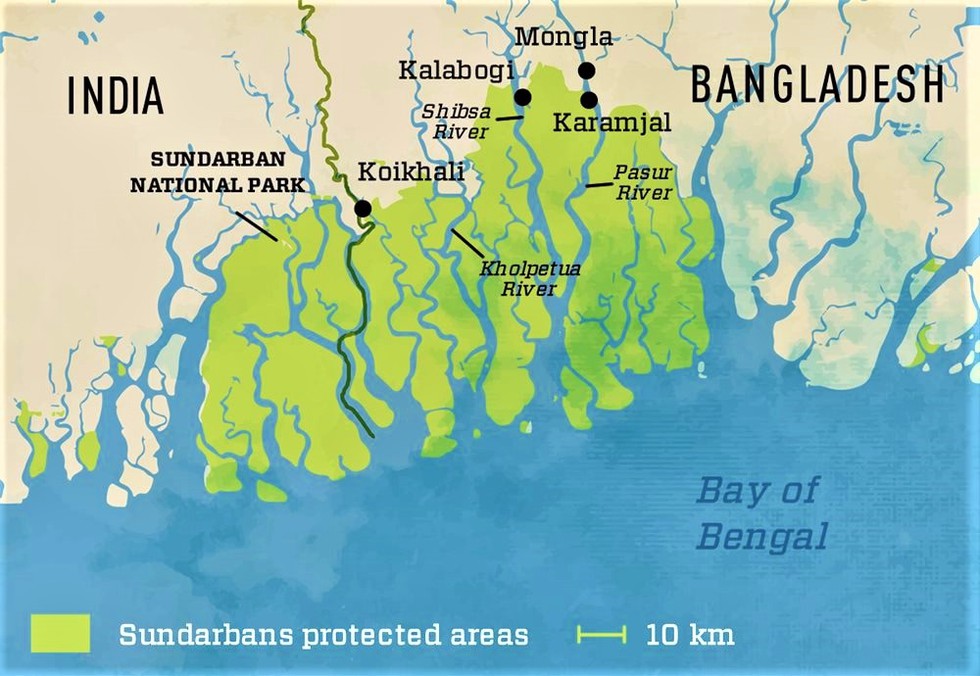
The world's largest single mangrove forest, the Sundarbans, is under severe ecological stress. Often called the ‘Lungs of Asia’, this critical ecosystem faces endangerment, despite being recognised as a ‘Protected Landscape’ by both India and Bangladesh. While both New Delhi and Dhaka have demonstrated political will towards its conservation, it is worth unpacking why the institutional safeguards in place have not translated into protection on ground. Such an investigation reveals that there are a whole host of factors that constrain conscientious governance, ranging from top-down factors like institutional shortcomings, and trends in bilateral relations between the two neighbours, to on-ground capacity and implementation issues.
Protective institutional measures
The Sundarbans hold great importance nationally, regionally, and globally, due to its rich biodiversity, ecosystem productivity, natural protection against cyclones and other disasters, and its status as the sole habitat for the Royal Bengal tiger. For India, this biosphere sustains over 4.5 million lives, propping up local industries and economic ventures in the region. Similarly for Bangladesh, as the country prepares to graduate from its ‘Least Developed Status’ by 2026, the Sundarbans play a crucial role in its economic development. It is the single-largest source of forest produce for the country and estimated that in FY2023, the environmental services rendered by the Sundarbans grossed over US$27.71 billion annually. Moreover, the landscape is also home to 1,000 different species flora and fauna.
Given its significance, both India and Bangladesh have taken various measures towards protecting and building climate resilience for this region. Both countries are signatories to the Ramsar Convention and have designated parts of the landscape as a protected site and a UNESCO World Heritage Site (India in 1987 and Bangladesh in 1997). India and Bangladesh also signed a Memorandum of Understanding (MoU) in 2011, reflecting the pressing need of the hour to jointly conserve the Sundarbans. This MoU recognised that the Sundarbans are a single ecosystem that required collaboration in monitoring and managing resources. Under this agreement, a Joint Working Group (JWG) was to be instituted to carry out information gathering, conservation, and development projects. The implementation of such a joint programme gained steam in 2015, at the Conference of Parties (COP) 21, where ministerial delegations from the two countries met to discuss the prospects of protecting common resources and building climate resilience in the region.
This MoU recognised that the Sundarbans are a single ecosystem that required collaboration in monitoring and managing resources.
And yet, no result
By tracing this timeline of events, it is evident that when it comes to the Sundarbans, both sides have demonstrated considerable political will towards recognising the joint responsibility of conserving this shared biosphere. However, the implementation of such dedication leaves much to be desired. This lack of action has rendered the biosphere “endangered” according to IUCN standards.
The environmental issues span anthropogenic and climatic factors. This includes air pollution arising from unchecked industrial activities, the forest fires caused by irresponsible foresting and unethical profiteering. The burgeoning populations in both countries put considerable stress on the forest resources. This has led to shortages in fresh-water availability and a reduction in agricultural output. Compounding the problem is the spectre of natural disasters. This low-lying coastal zone is most vulnerable to extreme variability in hydrological cycles leading to devastating cyclones and flooding. A steady sea-level rise has also contributed to increases in salinity levels and land submergence, leading to a loss of livelihood for humans and habitat for flora and fauna. The Indian Bengal Delta (IBD) is already considered to be one of the most vulnerable landscapes globally, and continued environmental degradation is bound to have a devastating impact on human security and regional stability, in the form of climate migration. In the face of such unsettling trends, an investigation into the causes of its decline is merited.

Source: Map of the Sundarbans
The discontents of institutionalism and prioritisation
The primary factor fracturing governance in the Sundarbans arises from the 2011 MOU itself. There is a general lack of a clear understanding of what geographically comprises the Sundarbans. In Bangladesh, the term applies to the extent of the forested region only whereas for India the term comprises the entire Sundarban Biosphere Reserve. This has given rise to two dual problems. Within India, while the Sundarban Biosphere has been designated under the Central Government’s prerogative, the inhabited area—that falls within the biosphere—is under the West Bengal state government’s jurisdiction. The Centre-State split between obligation and responsibility pertaining to the Sundarbans has caused fragmented management, a delay in communication, duplication of work, and encroachment of the land by those profiteering from the loopholes in authority. Secondly, by confining the scope of the agreement to the conservation of the forest, the agreement fails to address the broader challenges emerging from the nexus of human security and development in the region. For example, while the MOU speaks about developing a common vision of combating climate change and building resilience in the region, many pressing environmental issues such as sea-level rise, sediment flow depletion, land inundation and stream flow depletion find no mention in the vision. These challenges undoubtedly impact the flora and fauna of the region but also have wide-spanning consequences for human security of lives that lie beyond the ‘Protected Landscapes’ covered under this agreement. Storm surges, reduction in fresh water, mean sea level rise, and land submergence in the IBD have rendered thousands homeless, triggered migration, destroyed agricultural land, and forced the culture of mono-cropping. Thus, the effective operationalisation of the MOU is constrained by not recognising all relevant stakeholders and addressing the issues of the many livelihoods dependent on this ecosystem.
The secondary factor impacting governance in the Sundarbans is linked to where transboundary resource protection ranks on the bilateral agenda between the Indian and Bangladeshi governments, vis-a-vis other domains such as defence, economic growth, and national and regional development.
The secondary factor impacting governance in the Sundarbans is linked to where transboundary resource protection ranks on the bilateral agenda between the Indian and Bangladeshi governments.
There is a clear trend of prioritising developmental objectives and projects over cross-border conservation efforts. For instance, the same 2022 Joint Statement that called for the Sundarban JWG to be convened so that this “ecosystem… can live sustainably” also announced the unveiling of the Maitree (Rampal) Thermal plant. This joint venture between India and Bangladesh is one of the biggest coal-fired power plants to be established in Bangladesh and is expected to enhance its energy security by a capacity of 1320 MW. Across both sides of the border, this project has been lauded as an example of energy collaboration between the two neighbours.
However, there is a concerted contingent putting up resistance to this project. Environmental activists have warned against the destabilising impact the industrial runoff from this project will have on the Sundarbans, given that it is located a mere 14 kms from the Sundarban Reserve Forest Boundary. Researchers have asserted that the Rampal power plant would threaten the biodiversity of the Sundarbans irreversibly. Yet, the top brass at New Delhi and Dhaka highlight the geo-economic advantages project, emphasising the win-win nature of this developmental undertaking.
Finally, no discussion on transboundary landscapes is complete without regarding the intersectional and often intractable nature of governing such shared territorial bodies. Such areas require the cooperation of various actors and favourable conditions. As this piece has highlighted, two critical issues marring the Sundarbans are the decreasing fresh-water levels and land submergence. These issues can be traced to the contentious Farakka Barrage. Since its inception in 1975, this controversial dam has drastically altered the ecological landscape of the region, impeding the sediment depositing activity of the Ganges river, and contributing to a dramatic decline in freshwater discharge for the Sundarban region, as well as for Bangladesh on the whole. Despite signing two treaties, several MOUs, and escalating the at the United Nations, neither nation has been able to reach a consensus on a water sharing ratio that is feasible for both parties. Thus, while this issue remains in political limbo, the Sundarbans continue to suffer as collateral damage.
Even in cases like the Sundarbans where the respective nations recognised the joint nature of this ecosystem, its conservation efforts suffer policy logjams and implementation hurdles.
Transboundary ecosystems, landscapes, and resources suffer a tragic fate. It is a well-regarded fact that meaningful conservation and development of such natural resources should span its total expense. And yet, those landscapes that spill over international boundaries often become a site of competing national policies and objectives. Even in cases like the Sundarbans where the respective nations recognised the joint nature of this ecosystem, its conservation efforts suffer policy logjams and implementation hurdles. Moreover, such an agreement obfuscates the ground reality and presents the issue of conservation as a homogeneous issue across India and Bangladesh, diluting the representation of the perilous state of human security in the region. No stakeholder will disagree that critical interventions are needed to preserve the ‘Lungs of Asia’. The research exists. The institutional framework exists. The only thing lacking now is a push towards leveraging the existing indigenous human capacities and resources to clear out such institutional deadwood.
Roshani Jain is a Research Assistant at the Observer Research Foundation
The views expressed above belong to the author(s). ORF research and analyses now available on Telegram! Click here to access our curated content — blogs, longforms and interviews.





 PREV
PREV

.png)
.png)